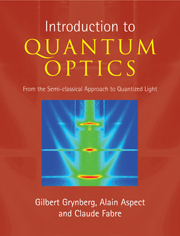Book contents
- Frontmatter
- Contents
- Foreword
- Preface
- Acknowledgements
- Part I Semi-classical description of matterlight interaction
- Part II Quantum description of light and its interaction with matter
- 4 Quantization of free radiation
- Complement 4A: Example of the classical Hamiltonian formalism: charged particle in an electromagnetic field
- Complement 4B: Momentum and angular momentum of radiation
- Complement 4C: Photons in modes other than travelling plane waves
- 5 Free quantum radiation
- Complement 5A: Squeezed states of light: the reduction of quantum fluctuations
- Complement 5B: One-photon wave packet
- Complement 5C: Polarization-entangled photons and violation of Bell's inequalities
- Complement 5D: Entangled two-mode states
- Complement 5E: Quantum information
- 6 Interaction of an atom with the quantized electromagnetic field
- Complement 6A: Hamiltonian formalism for interacting fields and charges
- Complement 6B: Cavity quantum electrodynamics
- Complement 6C: Polarization-entangled photon pairs emitted in an atomic radiative cascade
- Part III Applying both approaches
- Index
Complement 5B: One-photon wave packet
Published online by Cambridge University Press: 05 August 2012
- Frontmatter
- Contents
- Foreword
- Preface
- Acknowledgements
- Part I Semi-classical description of matterlight interaction
- Part II Quantum description of light and its interaction with matter
- 4 Quantization of free radiation
- Complement 4A: Example of the classical Hamiltonian formalism: charged particle in an electromagnetic field
- Complement 4B: Momentum and angular momentum of radiation
- Complement 4C: Photons in modes other than travelling plane waves
- 5 Free quantum radiation
- Complement 5A: Squeezed states of light: the reduction of quantum fluctuations
- Complement 5B: One-photon wave packet
- Complement 5C: Polarization-entangled photons and violation of Bell's inequalities
- Complement 5D: Entangled two-mode states
- Complement 5E: Quantum information
- 6 Interaction of an atom with the quantized electromagnetic field
- Complement 6A: Hamiltonian formalism for interacting fields and charges
- Complement 6B: Cavity quantum electrodynamics
- Complement 6C: Polarization-entangled photon pairs emitted in an atomic radiative cascade
- Part III Applying both approaches
- Index
Summary
One-photon sources are important elements in quantum optics. The archetypal example is an atom raised to an excited state at time t = 0, then de-exciting with emission of a single photon. The development of this kind of source depends on progress with experimental techniques, e.g. the possibility of isolating a single atom, molecule or quantum well. In this complement, we present the formalism for describing the corresponding radiation, and use it to discuss some spectacular experiments which bring out properties quite incompatible with a classical description of the electromagnetic field. We begin in Section 5B.2 by describing the anti-correlation between detections on either side of a semi-reflecting mirror, establishing the quantitative difference with a classical field. Section 5B.3 discusses a quantum optical effect that was only demonstrated at the beginning of the twenty-first century, namely the quantum coalescence of two one-photon wave packets on a semi-reflecting mirror, which occurs even when the two photons were emitted by independent atoms. An analogous effect, the Hong–Hou–Mandel effect, is discussed in Chapter 7. These effects exemplify quantum interference involving two photons. Finally, Section 5B.4 is concerned with quantum calculations involving quasi-classical states. As we now know, this leads to results that are identical to the predictions of semi-classical theory.
- Type
- Chapter
- Information
- Introduction to Quantum OpticsFrom the Semi-classical Approach to Quantized Light, pp. 398 - 412Publisher: Cambridge University PressPrint publication year: 2010

